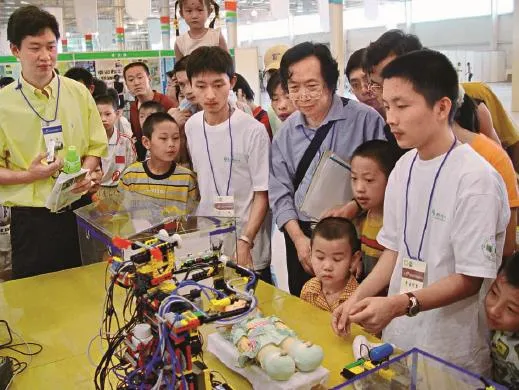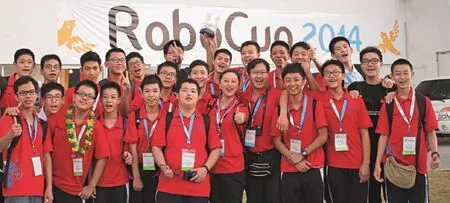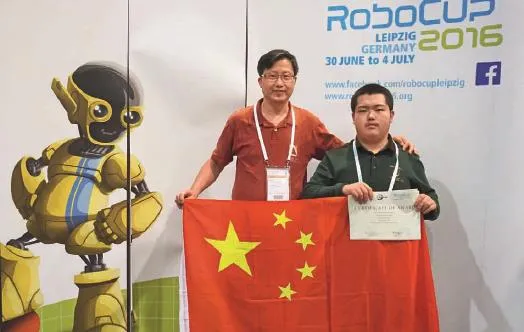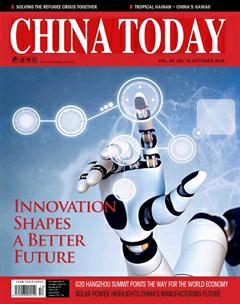Innovation Education in City of Makers - Shenzhen
By staff reporter ZHOU LIN
Innovation Education in City of Makers - Shenzhen
By staff reporter ZHOU LIN

Wang Mingyu, the current DJl vice president, displays his self-made robot while studying at the Shenzhen Experimental School.
Surroundings which activeiy encourage students’ innovative thinking, nurture a steady fiow of inventions.
AT the “International Exchanges on Open Innovation” held in San Francisco in 2015,one question was raised: “If you were an engineer and would like to make a creative idea into a product within one or two weeks, which city would be your choice?” Founder & CTO of Spark Labs Global Ventures, Zachary Crockett’s answer was Shenzhen. Known as entrepreneurs’ heaven,Shenzhen gives priority to innovation education and make students’ dreams reality.
Innovation: Soul of a Nation
SZ DJI Technology Co., Ltd. (DJI-Innovations,or DJI) situated in Shenzhen’s Nanshan District, is the global leader in developing and manufacturing high performance, reliable, and easy-to-use small unmanned aerial systems (UAS) or Unmanned Aerial Vehicles (UAV), for commercial and recreational use. Its series of drones have been reported in both The Wall Street Journal and The Times. The Phantom 2 Vision+, developed by the company’s vice president Wang Mingyu and his team, was selected as one of the Top 10 Gadgets of 2014 by Time magazine.
Wang Mingyu graduated from Shenzhen Experimental School, which was established in 1985 as the first municipal public school after the establishment of Shenzhen Economic Special Zone. Long Ping, vice principal and national special-honored teacher of the school, told China Today, “Our school has attached great importance to science and technology innovation since the presidency of the first principal. We believe that innovation is the soul of a nation, while science & technology innovation is the force behind social development.”
Early in the 1990s, to put innovative ideas into practice, the school established a curriculum system to promote the popularization of sciences and to enhance student scientific literacy. Meanwhile a large number of extracurricular interest groups have been set up, such as a Lego Association in the primary school, a Navigation Model Association in the junior middle school, and a Robot Association in the senior high school, so greatly inspiring students’ innovative enthusiasm. The Robot Association has since won abundant prizes at different levels of competitions ranging from municipal,provincial, and national contests to international competitions. It has even been named champion at the globally-recognized Robot World Cup (Robo-Cup) for six consecutive years.
In 2015, the Junior Academy of Sciences of Shenzhen Experimental School was set up. Zexiang Li, Professor of Electrical and Electronic Engineering at Hong Kong University of Science and Technology and also Chairman of DJI-Innovations,was especially invited and appointed as mentor. DJI was indeed born in Zexiang Li’s laboratory and then incubated for an IPO in Shenzhen before becoming the world’s leading developer and producer of drones.
Surroundings which actively encourage students’ innovative thinking nurture a steady flow of inventions. As of 2016, the school had already won81 National Patents for Utility Models (different from “National Patents for Invention”) some of which are now being put into actual use in cooperation with various enterprises.

Lihe Tailai and his Shenzhen Experimental School team win the 2014 RoboCup championship.
We are responsibie for buiiding an innovative piatform through which students can easiiy get heip with iaboratory equipment,funding and professionai tutorship.
Lihe Tailai, a senior at Shenzhen Experimental High School, is one of the “Little Academicians”of the Junior Academy of Sciences, established in 2015. During his studies in Shenzhen Experimental Primary School, he became hooked on robotic programming, and in 2008 the nine-year-old boy won the championship in the Guangdong Province robotic programming contest. Although busy with preparations for his college entrance examinations,he still maintains an enthusiasm for scientific research. He is currently working on an algorithm for a power-saving mode in an air conditioner.
“It can save half the power usage of an air-conditioner and is also a development trend for future Smart Homes,” Lihe Tailai said, adding that he had devoted almost all of his spare time to the laboratory. “Knowledge does not come only from our textbooks. It can also be obtained through extracurricular research and activities,” Li said.
Lihe Tailai is the team leader of the Robot Association in his school. His team recruits “green hands” from junior middle school and acts as their instructors in learning the basic skills of code programming and exploration on radio models until they grow mature enough to be assistants in robot competitions. When junior students develop enough scientific knowledge, they are encouraged to make inventions based on their own observations on life. For instance, some students have formulated a take-your-medicine reminder for the elderly,using intelligent sensors to read information on the packaging which then send signals to activate a reminder automatically at regular intervals.
Owing to the school’s environment of scientific innovation encouragement, teachers always support inventions and provide students with laboratory, funding and professional instructions. Dan Fei, one of the creators of Chaihuo Maker Space in Shenzhen, was invited to be their instructor.
“We should offer students more opportunities in compliance with their particular characteristics,”said Liu Haifeng, a national outstanding science & technology teacher with over 20 years’ teaching experience who came from Shanghai in 1991. He further explained, “Students have their own ideas. Sometimes, the current curriculum of national basic education cannot meet their needs, so selflearning is always required. We are responsible for building an innovative platform through which students can easily get help with laboratory equipment, funding and professional tutorship. In our school, students have a more flexible learning plan and get financial subsidies for their inventions.”
Innovation education is popular in Shenzhen schools. Long Cheng Primary School in Longgang District is famous for its 165 National Patents for Utility Models and six Little Academicians of the Chinese Junior Academy of Sciences. The automatic mop invented by Qiu Wensen has a huge market potential. It was produced in over 100 factories with a daily output of nearly 250,000, generating a value of RMB 20 million.
Lihe Tailai told China Today that his parents had their own start-up in Shenzhen after graduating from their respective universities. His family bought him a 3D printer for his scientific research.
“Everyone, every family, every school and enterprise here in Shenzhen encourages and supportsinnovation. Growing up in this environment, whenever you have a good idea you get the wherewithal to make it reality. You are inspired with passion for discovery and creation.”

Lihe Tailai and his teacher Liu Haifeng win the 2016 RoboCup in Germany.
To enhance students’ scientific and innovative capabiiity and cuitivate innovative science & technoiogy taients, the Shenzhen municipai government has made great efforts to buiid a distinctive brand for Shenzhen’s education.
Innovation Education
A cycle of innovation education has been formed between schools and enterprises in Shenzhen.
Chen Wei, a biology teacher from the Middle School Affiliated to Shenzhen University’s Normal College, said that according to the incentive policy of the Famous Teacher Plan for Shenzhen’s basic education system, she, as a famous teacher, has access to a biological laboratory with an investment of RMB 2 million (in which each microscope is worth RMB 100,000-200,000), all imported from Japan or Germany.
Chen has developed a series of school-based curricula for experimental classes, and in 2012 also established a Biological Association to promote students’ hands-on ability through creative thinking in biological research.
Questions students encounter in daily life are raised for further discussion and experiments are especially designed to find solutions. For example,should we eat last-night’s leftovers? Students design their own experiments for testing certain indicators and give advice on eating a healthy diet.
Pan Jingfang of the Biological Association said,“I benefit a lot from doing this self-designed experimentation. Working in a laboratory can be very tough and challenging as we have to make tests every six hours, each session lasting over three hours. Once we got home at 3 am! Team building is also very important; without the support of other members we could not achieve our stated goals. Last but not least, to finish these experiments we have to absorb lots of knowledge and are obsessed with new pharmaceuticals and equipment.”
Graduated alumni, once they have become innovative talents in society, can repay their alma mater. The Southern Raytai Group is a good example. It invested RMB one million in scientific innovation funds to help the school cultivate leading talents with strong innovation capabilities.
The city is building an international reputation for innovation education with the Shenzhen brand.
City of Makers
Robert O’Neill of the International City/County Management Association (ICMA) remarked that the key point of building the “City of Makers” is to see whether there is fertile soil among college graduates. In 2015, the success of the Innovation & Entrepreneurship Fair for College Students in Shenzhen, which was designed and implemented by Shenzhen Polytechnic, fully displayed the potential there.
He Renfeng is the design director of iDesign Cultural Broadcasting Limited Corporation which grew from an innovative program, and supported by the college is now a fruitful company in one office building of the campus.
“Innovative products are put on the school’s platform and linked with enterprises which have certain needs,” she explained. “Our program now cooperates with many companies in Beijing and continues to receive instructions from college teachers. This gives us a grace period without worrying about unstable team members and high rental in office buildings.” He added, “Most of our tutors are forefront designers in Beijing and Shanghai who would like to bring their programs to Shenzhen because of its atmosphere of entrepreneurship! Everything works perfectly well!” The toddler is now realizing its dream step-by-step under the care of the mother school.
“It is hard for college students to get specialized services for their ventures. With limited resources,students often feel frustrated whenever they meet problems in transforming their ideas into products,” Director of Shenzhen Polytechnic’s Teaching & Research Office Huang Weixian said. The school hence built its Innovation College and recruited sophomores with entrepreneurship potential through innovative programs. Colorful activities among different student associations also get financial support on campus.
To enhance students’ scientific and innovative capability and cultivate innovative science & technology talents, the Shenzhen municipal government has made great efforts to build a distinctive brand for Shenzhen’s education. By 2017, the city aims to develop 50 schools majoring in scientific education, build 30 science & technology innovative education bases, update 30 innovative laboratories, establish 100 factories for makers, and train 50-100 famous national teachers of science & technology and 100 Junior Scientists, as well as 1,000 student makers.

